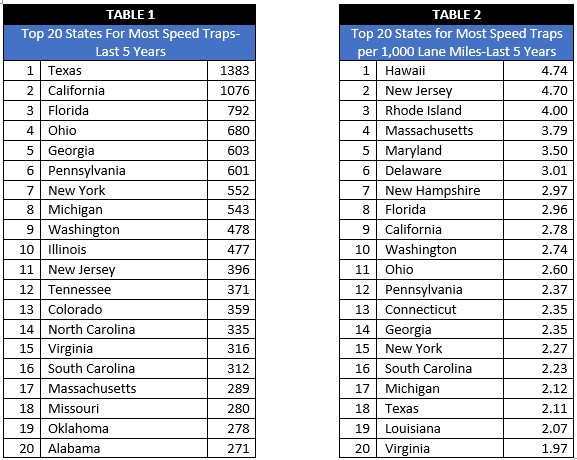The Top Speed Trap States
Left unchecked, so-called "Policing for Profit" can have disastrous consequences, as it did in Ferguson, Missouri, last year.
Since it's nearly impossible to find out how many speeding tickets are written in a given state, the National Motorists Association (NMA) looks at the presence of speed traps to gauge a state's propensity for revenue-based traffic enforcement.
Using data from its website, The National Speed Trap Exchange, the NMA has identified the worst states for speed trap activity throughout the country. Speed traps typically combine arbitrarily low speed limits with heavy traffic enforcement designed to generate ticket revenue. Speed traps often spring up in the same locations where the issuance of tickets continues unabated, indicating that the enforcement action has no meaningful effect.
Rather than emphasize overbearing traffic enforcement that doesn't change driver behavior, authorities should focus on setting speed limits based on the speeds people actually drive. Studies repeatedly have shown that setting speed limits this way results in the safest driving conditions.
The Speed Trap Exchange uses crowdsourcing to identify the specific locations of thousands of chronic speed traps throughout the United States. Information about each listing is enhanced with commentary from users, and site visitors can vote on whether they think a location is a speed trap or not.
The Methodology
To develop the rankings, the NMA compiled the number of speed traps reported over the last five years-November 1, 2010 through October 31, 2015-by state. Those totals were then indexed to the number of road miles in each state. Normalizing the data this way accounts for differences between states and allows more meaningful comparisons from state to state.
The Results
Table 1 shows the top 20 Worst Speed Trap States based on total number of speed traps added over the last five years, with Texas, California, Florida, Ohio and Georgia taking the top spots. Table 2 shows the top 20 Worst Speed Trap States based on number of speed traps per 1,000 lane miles. Hawaii, New Jersey, Rhode Island, Massachusetts and Maryland emerge as the top offenders. (Click here to see the rankings for all 50 states.)

"These results reveal which states are the habitual offenders when it comes to 'Policing for Profit,'" said NMA President Gary Biller. "They point to a need to reform the traffic justice system for greater accountability with less emphasis on generating revenue and more on public safety."
The NMA encourages everyone to drive safely this holiday weekend and that includes knowing what to expect when you hit the road. Visit www.speedtrap.org before you travel to see where you're likely to find the most speed trap activity on your journey.
